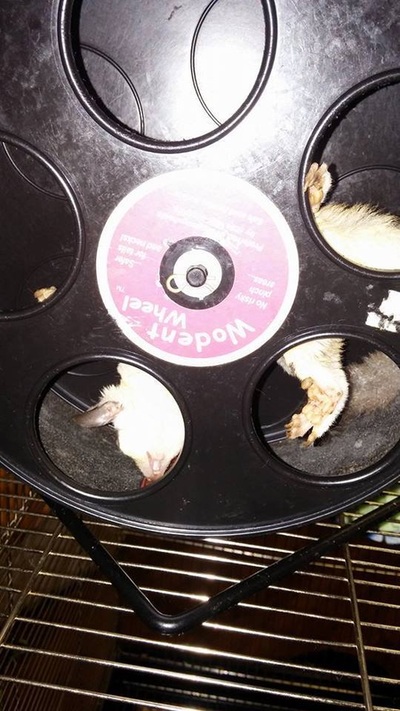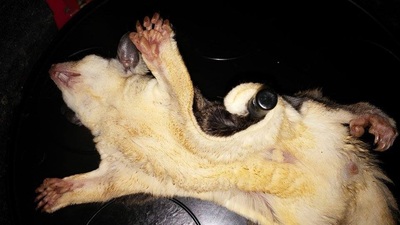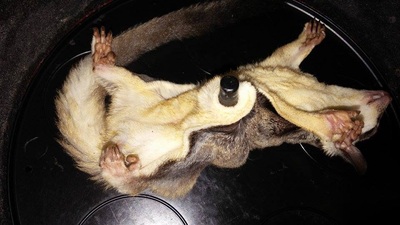Do I need a vet?
Absolutely! An exotic veterinarian is needed to provide proper medical and general wellness care for your sugar gliders. You also need to have a veterinarian that is available for emergency calls after normal business hours and on holidays. Typically when an emergency occurs, since sugar gliders are nocturnal, we notice the problems after hours. Many times, vet care cannot wait until the office opens the next morning. You need to have an established Vet-Client-Patient relationship prior to having any type of medical issues. This is done by finding a vet and having annual or semi-annual wellness checks with fecal exams on your gliders. This also establishes a baseline for your vet to help in diagnosing symptoms that are not normal for your glider. You do not want the first visit to be an emergency as the vet has no previous records to compare.
Glider are susceptible to parasites, illness, and disease just like any other living creature. Although they do not require vaccinations, they do require regular wellness exams. Sugar gliders, although generally a healthy species have been known to have bacterial diseases, protozoal disease, parasitic disease, dental disease, nutritional osteodystrophy, urinary tract disorders, neurologic disorders, neoplasia, liver issues, congestive heart failure, cancer, fibrosis, among many others. Some diseases that are potentially zoonotic include toxoplasmosis, leptospirosis, salmonellosis, giardiasis, and clostridiosis.
Vet expenses range greatly from one vet to another, as well as from one region of the country to another. It is simply not logical to give price ranges on vet expenses.
Glider are susceptible to parasites, illness, and disease just like any other living creature. Although they do not require vaccinations, they do require regular wellness exams. Sugar gliders, although generally a healthy species have been known to have bacterial diseases, protozoal disease, parasitic disease, dental disease, nutritional osteodystrophy, urinary tract disorders, neurologic disorders, neoplasia, liver issues, congestive heart failure, cancer, fibrosis, among many others. Some diseases that are potentially zoonotic include toxoplasmosis, leptospirosis, salmonellosis, giardiasis, and clostridiosis.
Vet expenses range greatly from one vet to another, as well as from one region of the country to another. It is simply not logical to give price ranges on vet expenses.
Neuters
Male sugar gliders can be neutered to prevent the increase of testosterone in the body, prevent reproduction, and reduce the risk of testicular cancer. (I am currently not aware of a case of testicular cancer in sugar gliders.) Neuters are a fairly simple procedure and is relatively non-invasive to the male sugar glider. Neuters can be done with a scalpel or by laser. Many refer to the procedures as "Pom On" or "Pom Off". This means that their scrotum, or "pom" is left on or entirely removed. The style of procedure is up to the client and the veterinarian. There has been no proof that one procedure is better.
If your veterinarian would like information on conducting laser neuters, please have them contact me for an informational video. Videos will only be sent to licensed veterinarians. The surgical procedure in the video is conducted by Dr. Matthew Klingman, DVM with Wellington Veterinary Clinic and is a Clean Cut Laser procedure.
If your veterinarian would like information on conducting laser neuters, please have them contact me for an informational video. Videos will only be sent to licensed veterinarians. The surgical procedure in the video is conducted by Dr. Matthew Klingman, DVM with Wellington Veterinary Clinic and is a Clean Cut Laser procedure.
Spaying Females
Spaying a female is not recommended unless it is medically necessary. Spaying should never be done as a method of preventing offspring. Neutering the males is a much safer procedure.
The female reproductive system is a very intricate double system. Where most mammals have a single uterus, a sugar glider has two. In order to access the reproductive system, a very difficult procedure must be conducted. Since their system is behind their pouch, it is difficult to reach. Internal organs must be exteriorized to reach the ovaries making this a dangerous procedure. This is not a recommended procedure to perform.
The female reproductive system is a very intricate double system. Where most mammals have a single uterus, a sugar glider has two. In order to access the reproductive system, a very difficult procedure must be conducted. Since their system is behind their pouch, it is difficult to reach. Internal organs must be exteriorized to reach the ovaries making this a dangerous procedure. This is not a recommended procedure to perform.
Illnesses & Injuries
Below are some real illnesses and injuries that occurred with sugar gliders and the amount of vet care each situation required. Not every glider survived.
**More Pictures coming soon!**
**More Pictures coming soon!**
Photos and situations are published with express permission by the owners.
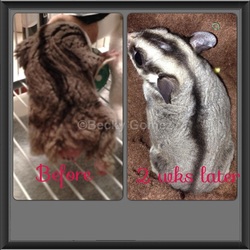
Notice the difference in the color and texture of the fur after only 2 weeks of being on a nutrional diet!
Rescued glider was fed ferret pellets, kept in small cage with pine shavings, had injured tail, and was full of infection from injury and weakened immune system. After having the tail amputation, the glider began to self-mutilate due to the infection.
Care required 3 vet visits, various medications and surgery costing over $400.00
Rescued glider was fed ferret pellets, kept in small cage with pine shavings, had injured tail, and was full of infection from injury and weakened immune system. After having the tail amputation, the glider began to self-mutilate due to the infection.
Care required 3 vet visits, various medications and surgery costing over $400.00
A beloved pet sugar glider with its patagium entangled on the center bar of a wheel. Becoming entangled caused serious injury that resulted in death. The owner used this wheel for approximately a year without issue; until this horrific morning when she woke and found the glider already passed in this position. Glider-safe products may cost a bit more to purchase up front, but can save a gliders life. Please research products before purchasing them.
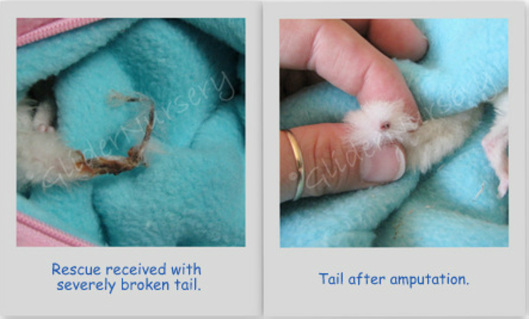
Rescue received with a severely broken tail.
Amputation surgery was approximately $200.00
E-Collars & E-Jackets
The following list is a general guidance of the types of injuries that require e-collars or e-jackets, and which style typically works the best. Please keep in mind that every situation is different, and one style may work better for your particular glider than another. The list below is to be used as a guide. In any case that an e-collar is needed, take your glider to the veterinarian immediately.
Satellite E-Collar
Use for injuries or post-surgery for upper torso of body
Shotglass E-Collar
Use for injuries or post-surgery for lower torso of body:
Injuries that should NOT be e-collared:
E-Jacket
Satellite E-Collar
Use for injuries or post-surgery for upper torso of body
- Post Neuter
- Upper Patagium Injury
- Tail amputations only if more than half of the tail has been removed
- *using medication that gliders are NOT allowed to lick off
Shotglass E-Collar
Use for injuries or post-surgery for lower torso of body:
- Tail injury/surgery
- Cloacal SM
- Leg/foot injury
- Lower Patagium Injury
- Prolapsed penis/cloaca
- Self-mutilation ANYWHERE
- Using medication that gliders are NOT allowed to lick off
Injuries that should NOT be e-collared:
- Mating Wounds
- Dominance Wounds
E-Jacket
- Cloacal injuries
- Post-neuter Self-Mutilization
- Tail amputations (depending on tail length)
- Mating/Dominance Wounds (depending on location)
- UTI related over grooming
- Prolapsed penis issues
Physiologic Information
|
Average Lifespan
Puberty (in the wild) (Males have bred at 12 weeks OOP, and females 16 weeks) Estrus Gestation period Litter size Pouch emergence Weaning Adult male body wt Adult female body wt Body temperature Food consumption Heart rate Respiratory rate Thermoneutral zone - temperature tolerance range |
9-12 years on average
7-10 months 29 days 15-17 days 2 average, although singles and triplets occur 70-74 days 110–120 days 115–160 g 95–135 g 97.3°F (36.3°C) 15–20% body wt/day 200–300 bpm 16–40/min 80–88°F (27–31°C) |
Information obtained from the Merck Veterinary Manual

